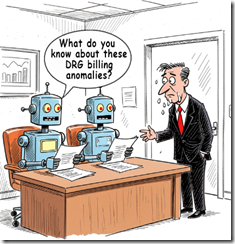Medical Fraud Meets AI. DRG Codes Meet AI. Enjoy
November 4, 2025
 This essay is the work of a dumb dinobaby. No smart software required.
This essay is the work of a dumb dinobaby. No smart software required.
I have heard that some large medical outfits make use of DRG “chains” or “coding sequences.” I picked up this information when my team and I worked on what is called a “subrogation project.” I am not going to explain how subrogation works or what the mechanisms operating are. These are back office or invisible services that accompany something that seems straightforward. One doesn’t buy stock from a financial advisor; there is plumbing and plumbing companies that do this work. The hospital sends you a bill; there is plumbing and plumbing companies providing systems and services. To sum up, a hospital bill is often large, confusing, opaque, and similar to a secret language. Mistakes happen, of course. But often inflated medical bills do more to benefit the institution and its professionals than the person with the bill in his or her hand. (If you run into me at an online fraud conference, I will explain how the “chain” of codes works. It is slick and not well understood by many of the professionals who care for the patient. It is a toss up whether Miami or Nashville is the Florence of medical fancy dancing. I won’t argue for either city, but I would add that Houston and LA should be in the running for the most creative center of certain activities.

“Grieving Family Uses AI Chatbot to Cut Hospital Bill from $195,000 to $33,000 — Family Says Claude Highlighted Duplicative Charges, Improper Coding, and Other Violations” contains some information that will be [a] good news for medical fraud investigators and [b] for some health care providers and individual medical specialists in their practices. The person with the big bill had to joust with the provider to get a detailed, line item breakdown of certain charges. Once that anti-social institution provider the detail, it was time for AI.
The write up says:
Claude [Anthropic, the AI outfit hooked up with Google] proved to be a dogged, forensic ally. The biggest catch was that it uncovered duplications in billing. It turns out that the hospital had billed for both a master procedure and all its components. That shaved off, in principle, around $100,000 in charges that would have been rejected by Medicare. “So the hospital had billed us for the master procedure and then again for every component of it,” wrote an exasperated nthmonkey. Furthermore, Claude unpicked the hospital’s improper use of inpatient vs emergency codes. Another big catch was an issue where ventilator services are billed on the same day as an emergency admission, a practice that would be considered a regulatory violation in some circumstances.
Claude, the smart software, clawed through the data. The smart software identified certain items that required closer inspection. The AI helped the human using Claude to get the health care provider to adjust the bill.
Why did the hospital make billing errors? Was it [a] intentional fraud programmed into the medical billing system; [b] was it an intentional chain of DRG codes tuned to bill as many items, actions, and services as possible within reason and applicable rules; or [c] a computer error. If you picked item c, you are correct. The write up says:
Once a satisfactory level of transparency was achieved (the hospital blamed ‘upgraded computers’), Claude AI stepped in and analyzed the standard charging codes that had been revealed.
Absolutely blame the problem on the technology people. Who issued the instructions to the technology people? Innocent MBAs and financial whiz kids who want to maximize their returns are not part of this story. Should they be? Of course not. Computer-related topics are for other people.
Stephen E Arnold, November 4, 2025
Comments
Got something to say?


